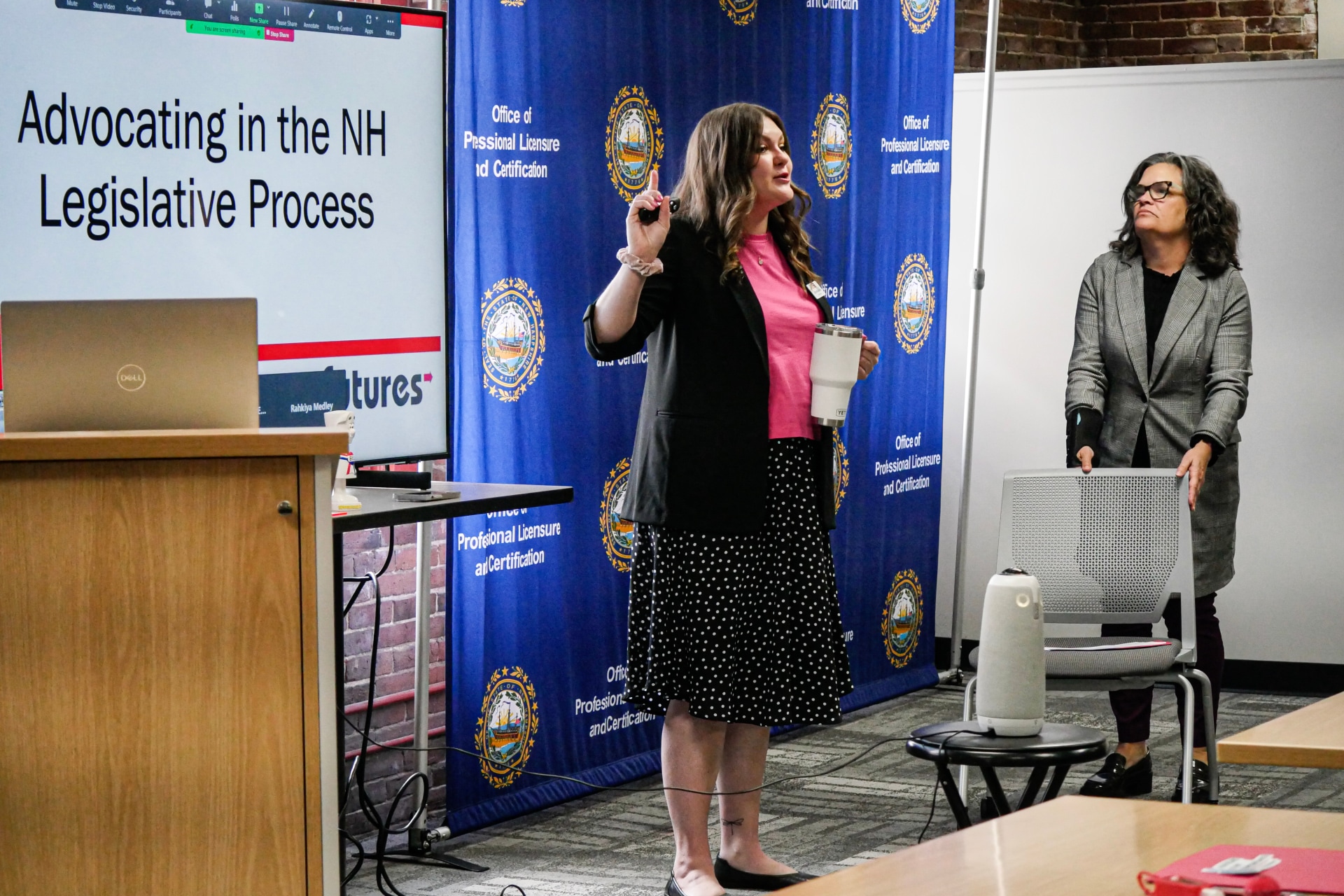
Personal stories are one of the greatest advocacy tools; everyone has them! Sharing a personal experience helps people understand the real-life impact policy will have. Stories can motivate
people to take action on an issue and work toward change.
There are many ways to advocate for issues you care about.
Ways to Advocate
Remote Sign-In and Testimony at Public Hearings
Committees are tasked with studying bills more in-depth and reporting back to the full legislative body with a recommendation. The public hearing is your opportunity to have direct input on the future of a bill by providing testimony.
Remote Sign In
Remote sign-in is a relatively new option in New Hampshire and greatly increases the opportunity for public input on legislation.
- It takes 1-2 minutes to register your opinion on a bill using Remote Sign-In.
- After you sign in, spread the word and encourage others to do so as well! The number of sign-ins in support or opposition of a bill can be a powerful message to committee members.
How to Sign In on a Bill
- Go to the GenCourt website and scroll to "Meeting Resources" on the homepage. Know which body the bill is currently in, then select "House Sign-In Form and Online Testimony Submission" or "Senate Remote Sign-In."
- Fill in your name, town, and email address.
- Select the date of the hearing.
- Select the committee.
- Choose the bill number.
- Select "I am: a member of the public" unless one of the other labels is appropriate to you.
- Fill in "I'm Representing: Myself" unless you are approved to represent another entity (i.e. your workplace or an organization)
- Select whether you support, oppose, or are neutral on the bill.
- In the House, you have the option to upload or type in your testimony. Note: This becomes immediately visible on the website to anyone. You can also submit your testimony by emailing the committee through the Committee's page on the GenCourt website (this still becomes part of public record, but is not immediately visible on the Remote Sign-In page).
Written Testimony
- Write your personalized advocacy message in the form of a letter.
- Address it to "Honorable Chair and Members of the Committee"
- Sign with your full name, your town, and your contact information.
- Submit your testimony:
- Senate: Got to the Committee's page on the GenCourt website and click "Email Entire Committee"
- House: There is the option to include your testimony during Remote Sign-In for the hearing. Please Note: this becomes immediately visible on the website to anyone. You can email committee members if you prefer.
In-Person Testimony
-
PREPARATION
- Write your personalized advocacy message in the form of a letter.
- Address it to “Honorable Chair and Members of the Committee”
- Sign with your full name, your town, and your contact information.
- Bring printed copies to the hearing to hand in for the committee members. (25 copies for the House, 7 for the Senate)
- Create a bulleted list of talking points to help you stay on track while you speak. You should not just read from your testimony.
- Hearing times vary widely. Anticipate the hearing may run late.
-
ARRIVING TO A HEARING
- Arrive early, and plan extra time for parking.
- Know the bill number and hearing room number.
- In the Senate: There will be a white sign-in sheet where you will write your name, whether you support or oppose the bill, and whether you wish to speak.
- In the House: There will be a blue sign-in sheet that you only fill out if you are not speaking. If you would like to speak, fill out a pink card and pass the card to the clerk or chair of the committee.
-
TESTIFYING
- We recommend keeping testimony under 3-5 minutes to remain effective and hold the committees attention.
- Recognize the chairperson and members of the committee.
- State your name and where you are from.
- State your position on the bill.
- Share your personalized advocacy message.
- Thank the committee members for their time.
- You have the option to accept or decline questions from the committee at the end of your testimony. If you do not know an answer, offer to follow up with an email. You can email all members of the committee through the GenCourt website.
Interested in attending a hearing in person? We can help you prepare remarks, find the committee room, and offer moral support at the hearing.
Phone Calls and Emails
Phone Calls to Legislators
A phone call is the most effective way to contact a legislator when advocating on a specific issue or bill. It is helpful for many people to prepare beforehand. Here is a sample script:
"Hello Representative/Senator_____________. My name is ____________, and I live in your district in the town of _______________.
I am calling to ask you to support/oppose (bill #, issue).
(Share brief version of personalized advocacy message. Bullet points are helpful).
Thank you for your time and consideration on this issue."
- Be conscientious of what time you are calling a legislator.
- Keep conversations short and respectful of a legislator's time.
- If you would like to have a longer conversation, ask to set up a meeting.
- If they do not answer, leave a brief message with your name, the town in which you live, and your phone number.
- Senators have a staff person who answers their phone. Representative phone numbers are their personal numbers, so sometimes a family member will answer the phone. Politely ask to leave your name and number with them.
Emailing a Legislator
Emails are best used to follow up a phone call with additional information. If you are using email to initially contact a legislator, be sure to put in the subject line "Constituent of (your town) (bill number) (issue)." Legislators get a lot of emails, and this is one way to increase the likelihood yours will be seen. Include your contact information in the signature of the email.
Letters, OpEds, Social Media
LETTER TO THE EDITOR
A Letter to the Editor (LTE) is one way to advocate to both legislators and the public. Legislators often read local newspapers to understand the concerns of their constituents. LTEs should be submitted to local newspapers who cover the area in which you live.
Writing: LTEs are usually under 250 words. Check with your local newspaper for their word limit. An effective LTE has three components - an introduction to the topic, a short personalized advocacy message, and a clear ask.
Submission: Most local newspapers have online forms for submitting LTEs. Look up online where and how to submit. Make sure to include your contact information and your address when submitting. These things won’t be printed, but are used to verify that you are a local resident.
OPINION EDITORIALS
An Opinion Editorial (Op-Ed) is longer and more in-depth than an LTE. This is a good option if you are a subject matter expert or have lots of information to share on a topic. Op-Eds are
usually 600 - 800 words. They should be submitted via email to the Opinion or Executive Editor of your local newspaper.
SOCIAL MEDIA
Social media can be used to inform legislators and the public about an issue you are advocating around. It is good for building awareness and spreading information. The Golden Rules for Advocates apply the same online as they do offline.
Lobbying vs. Advocacy
Not all advocacy is lobbying, but all lobbying is advocacy.
- Advocacy ≠ Lobbying
- Always check with your organization first
- Restrictions have to do with state vs federal funding
- You can always advocate off-the-clock
- Lobbying requires a direct “ask.” Example: asking a legislator to make changes to a bill
- You can always advocate by educating!
- 501(c)(3) organizations CAN lobby if it constitutes 5% of annual budget or less
- If you want to know more, we offer a full two-hour training
The Power of Stories
Contacting Your Legislators
Stories Humanize Policy
How do you tell a personal story effectively? By telling a solutions-focused story that appeals to both the head and the heart. Your personal story appeals to the heart. Appeal to the head b y supplementing factual information. Introduce yourself in a way that establishes relevance or credibility. Discuss the issue or challenge, then focus on the desired change or solution. Focusing only on the challenge leaves the audience without a course of action toward change. Illustrate what the impact of the solution will be. The impact is a motivator and serves as a vision or goal to work toward.
-
Introduction: Introduce yourself and any relevant identities or information about yourself.
- Challenge: Describe a challenge faced. Include factual information.
- Solution: Illustrate a solution or proposed solution to the challenge - the change you want to see made.
- Impact: Share how the solution will create impact.
An effective advocacy message appeals to both the head and the heart and concludes with a specific ask. Your personal story appeals to the heart. Appeal to the head by supplementing factual information. Conclude with a clear and specific ask - what do you want people to do?
- Personal story
- Factual information
- Specific ask


